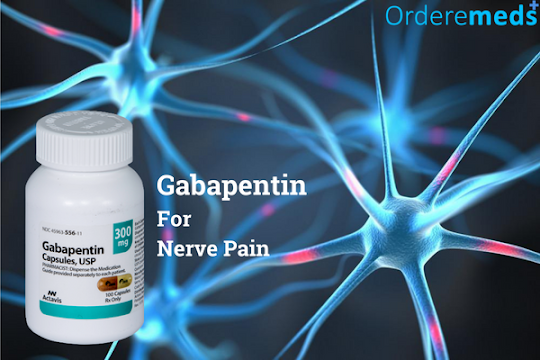The effectiveness of Gabapentin for treating neuropathic pain
Introduction
Neuropathic pain is a chronic condition that is characterized by chronic pain in the nerves and can be caused by various factors such as injury, disease, or nerve damage. This type of pain can be difficult to treat and manage, making it an ongoing challenge for many individuals. However, there are several options available for managing neuropathic pain, including medications such as Gabapentin.
Gabapentin is a medication that was initially approved for the treatment of epilepsy, but has since been found to be effective in treating a variety of other conditions, including neuropathic pain. It works by affecting the nerve signals in the brain, which helps to reduce the sensations of pain. Gabapentin is considered to be a relatively safe and well-tolerated medication, making it a popular option for managing neuropathic pain.
In this blog, we will discuss the effectiveness of Gabapentin for treating neuropathic pain, how it works, and the potential benefits and drawbacks of using it for this condition. Before starting any new treatment, it is important to speak with a healthcare provider to determine what is best for your individual needs and medical history.
How Gabapentin works for neuropathic pain
Gabapentin works by affecting the nerve signals in the brain and spinal cord, which helps to reduce the sensations of pain. It is believed to work by increasing the production of neurotransmitters in the brain, which help to regulate pain signals. Gabapentin is considered to be a relatively safe and well-tolerated medication, making it a popular option for managing neuropathic pain.
The mechanism of action of Gabapentin is still not completely understood, but it is thought to work by reducing the release of certain neurotransmitters, such as glutamate, that contribute to the sensations of pain. This helps to reduce the pain signals that are transmitted to the brain, which in turn helps to reduce the severity of neuropathic pain.
Compared to other neuropathic pain treatments, Gabapentin is relatively non-invasive and has fewer side effects. It can be taken orally in pill form and is absorbed into the bloodstream quickly, making it a convenient option for many individuals. Additionally, Gabapentin has a relatively low risk of abuse and dependence, making it a safer option compared to other pain medications.
In the next section, we will discuss the efficacy of Gabapentin for treating neuropathic pain, including the results of clinical trials and studies and individual experiences with this medication.
Efficacy of Gabapentin for neuropathic pain
Clinical trials and studies have shown that Gabapentin can be effective in reducing neuropathic pain. In several studies, Gabapentin has been found to reduce the severity of neuropathic pain by up to 50% in some individuals. This has led to its widespread use as a treatment option for neuropathic pain.
Compared to other neuropathic pain treatments, Gabapentin has been found to be just as effective, if not more so, in reducing neuropathic pain. It is also generally well-tolerated, with fewer side effects compared to other pain medications. This makes it a popular choice for individuals who are seeking a non-invasive treatment option for neuropathic pain.
Individual experiences with Gabapentin for neuropathic pain vary, but many individuals report significant reductions in pain after starting this medication. Some individuals may experience side effects, such as drowsiness, dizziness, or blurred vision, but these side effects are typically mild and go away with time.
In the next section, we will discuss the recommended dosages and administration of Gabapentin for neuropathic pain, as well as the potential side effects and precautions to be aware of when using this medication.
Dosage and administration of Gabapentin for neuropathic pain
The recommended dosage of Gabapentin for treating neuropathic pain varies depending on the individual and the severity of their pain. It is typically started at a low dose and gradually increased over time, as needed. The maximum dose of Gabapentin for treating neuropathic pain is generally considered to be around 3600 mg per day, although higher doses may be used in some cases.
Gabapentin should be taken orally, typically in pill form, with or without food. The frequency of doses may also vary, but it is typically taken 2-3 times per day. It is important to follow the recommended dosages and administration instructions provided by a healthcare provider, as taking too much Gabapentin can lead to serious side effects.
It is also important to note that the effects of Gabapentin may take several weeks to be fully felt, and it may take several months to determine if it is an effective treatment option for an individual. It is important to be patient and work closely with a healthcare provider to determine what is best for your individual needs and medical history.
In the next section, we will discuss the potential side effects and precautions to be aware of when using Gabapentin for neuropathic pain.
Potential side effects and precautions of Gabapentin for neuropathic pain
Like all medications, Gabapentin can cause side effects in some individuals. The most common side effects of Gabapentin for neuropathic pain include drowsiness, dizziness, and blurred vision. These side effects are typically mild and go away with time.
More serious side effects of Gabapentin, such as difficulty breathing, swelling of the face or tongue, or hives, are rare but can occur. If you experience any serious side effects while taking Gabapentin, it is important to seek medical attention immediately.
Gabapentin may also interact with other medications, including opioids, so it is important to inform a healthcare provider of all medications you are taking. It is also important to inform a healthcare provider of any allergies or medical conditions, as Gabapentin may not be safe for everyone.
In addition, it is important to be aware of the potential for abuse and dependence with Gabapentin, as it is classified as a controlled substance in some countries. Misusing Gabapentin can lead to serious side effects, including overdose.
In conclusion, Gabapentin is a medication that has been found to be effective in treating neuropathic pain. It is considered to be a relatively safe and well-tolerated medication, but it is important to be aware of the potential side effects and to work closely with a healthcare provider to determine what is best for your individual needs and medical history.
Read more about gabapentin here
Conclusion
In conclusion, Gabapentin is a medication that has been shown to be effective in treating neuropathic pain. It has been found to be just as effective, if not more so, than other neuropathic pain treatments, and is generally well-tolerated, with fewer side effects compared to other pain medications.
However, it is important to be aware of the potential side effects and precautions of Gabapentin, and to work closely with a healthcare provider to determine what is best for your individual needs and medical history. This includes considering the recommended dosages and administration instructions, as well as informing a healthcare provider of all medications you are taking and any medical conditions or allergies.
Ultimately, Gabapentin has the potential to be a helpful and effective treatment option for individuals with neuropathic pain, and is worth considering as a part of a comprehensive pain management plan. If you are experiencing neuropathic pain and are interested in exploring treatment options, talk to your healthcare provider to see if Gabapentin may be right for you.

.png)

Comments
Post a Comment